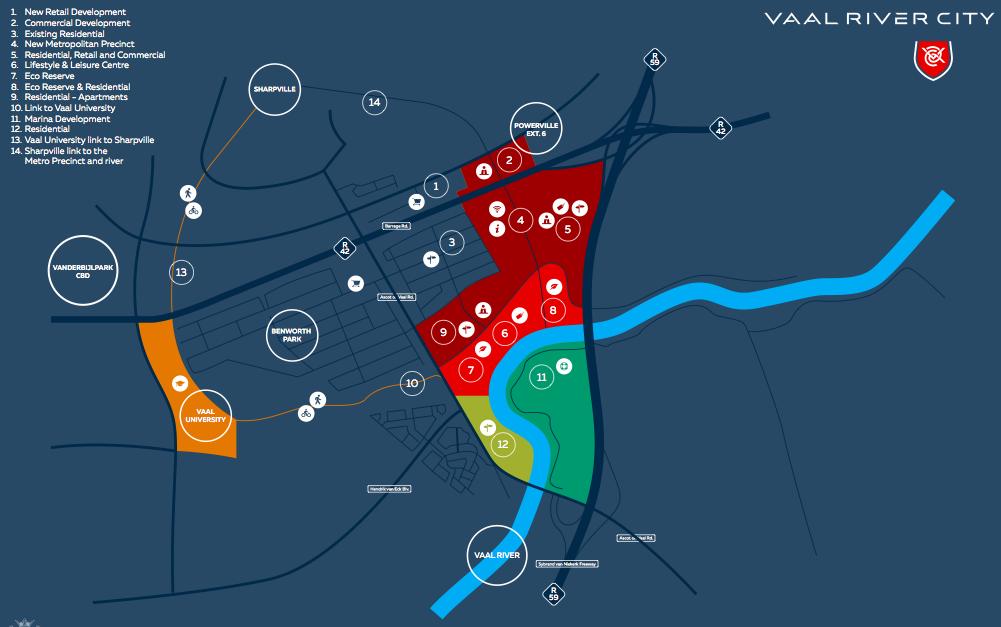
4 minute read
Growing the Vaal River economy
The development of the Vaal region places an emphasis on projects that entail the development of tourism related to the Vaal River precinct and waterfront. It also entails the urban renewal of centres such as Evaton, Vanderbijlpark and Vereeniging.
The Vaal development initiative The municipalities involved from the Gauteng is a cross-border agreement side are Sedibeng District Municipality between municipalities in and Lesedi, Emfuleni and Midvaal local Southern Gauteng and the municipalities, while the Free State is northern Free State to work together to develop represented by Fezile Dabi District Municipality a regional economy around both banks of and Metsimahole, Ngwathe, Mafube and the Vaal River. Moqhaka local municipalities.
Advertisement
The former Vaal Triangle was an example The initiative covers numerous towns, such as of a regional economy based around the Vaal Heidelberg, Ratanda, Meyerton, Vaal Marina, River. The new initiative brings together the Sharpeville, Boipatong, Sebokeng, Bophelong, existing industries and natural resources Deneysville, Oranjeville, Parys, Tumahole, that exist in this regional economy and Vredefort, Sasolburg, Zamdela, Kroonstad, revitalise the economic contribution of this Villiers and Frankfort. These towns are situated well-located region. on either side of the Vaal River. Economically, industrial growth in the region is concentrated around electricity, coal, steel and petrochemicals. Agriculture is a significant economic sector, while tourism and the diamond industry are growing. Significant rail, road and pipeline corridors run through the area, connecting it with the rest of South Africa and the continent.
The area has a rich history that spans many ages. Significant historical sites include the prehistoric Vredefort Dome, which is the largest meteorite site in the world; Redan rock art and various Bushmen paintings from the iron age; major sites of the Anglo-Boer War, including the site of the war-ending Treaty of Vereeniging; and major liberation struggle sites, since the area was home to the Sharpeville massacre in 1960, the Boipatong massacre in 1992, as well as Vaal uprisings in 1984.
Flagship Projects
The overarching Vaal development programme will be driven through a series of flagship
projects, which individually and collectively aim to: • Enable development – e.g. a new regional sewer works, an air quality management plan and enabling upstream and downstream manufacturing in the minerals and energy sector. • Accelerate growth – e.g. new Heineken brewery, upgrading the R57, upgrading the airfields in
Parys and Kroonstad. • Promote urban renewal – e.g. Sharpeville Precincts,
Evaton Renewal, township upgrading and beautification in areas such as Zamdela and others. • Promote tourism and leisure – e.g. the development of an urban waterfront (at
Vereeniging and Sasolburg), Vaal Dam and
Vredefort Dome developments. Some of the flagship projects have already been or are being undertaken, others are in the planning stages and some are proposed. Some are the responsibility of local government, others are being undertaken in partnership between different spheres of government, and others are projects that are being led entirely by the private sector.
Unlocking the region
The Vaal River System Intervention is one of the contributors towards turning around regional sanitation infrastructure rehabilitation and upgrades. The upgrading of the Vaaloewer Water Treatment Plant and the construction of the elevated steel tank at the Vanderbijlpark Reservoirs to ensure constant supply of water to the community of Emfuleni Local Municipality are all part of this intervention.
Furthermore, the Growth and Development Strategy advocates for the building of the marine economy. The following projects have

previously been noted to be prioritised: ABInBev investment – Project Isanti and Project Jordan; the Vaal Aerotropolis – Logistical Hub and Airport; professionalising infrastructure provision; and the development of agri-parks. It was further reaffirmed that the Vaal River City is still effectively a vision that needs to be pursued to unlock the economic potential of the region.
Apart from its water supply function, the Vaal River is almost unique in the Gauteng area for the opportunity it provides for tourism and upmarket residential development. It would, however, be important to ensure that the water supply capacity and conservation value of the Vaal River (both existing and potential) are not threatened by any development.
Key to the success of development opportunities along the banks of the Vaal River is the adequate provision for public access to the river for leisure and recreation. Currently, the ever-increasing private property development along the river is making it increasingly difficult for local tourists and members of the public to gain access to the riverfront.
Strategies aimed at reversing the current pollution levels around the Vaal River such as interventions by the South African National Defence Force and continuous civic education are absolutely necessary. It is also essential to ensure that preventative as well as remedial measures be taken in this regard. Any development along the Vaal River should be an asset to the local residents. All activities should be promoted to become a value chain as opposed to an ad-hoc development vision.
Operating principles
The concerned Vaal municipalities have committed themselves to collectively grow and stimulate the Vaal regional economy through the following philosophies: • by creating an enabling environment and infrastructure • through short-term and long-term catalytic projects, which could be new or existing, implemented by individuals or collectively • by maximising the potential of the region’s heritage, the river and the dam, to ensure public access and usage of the river system (both waterways and banks) • through ensuring clean air and water and safeguarding the biodiversity of the area and river system • by aligning to the Growth and Development
Strategies and other government priorities • by incorporating the projects in the
Integrated Development Plans • through promoting good governance and accountability • by healthy collaboration between municipalities • by creating and strengthening partnerships with all stakeholders and promoting community participation • by respecting the mandate of the collective and legal and constitutional imperatives.








